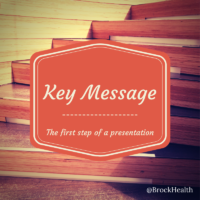You have a presentation to give and you are not sure where to begin. The introduction? The supporting material? Research?
Before doing any of the above, there is one step you must do first. Decide on your key message.
What do you want your audience to remember when they leave?
Because if you are not clear on your message, how can it be clear for your audience? Some of the worst presentations are those where you leave not knowing what was the point of the presentation.
How do you avoid being one of these speakers? Here are some tips to get you started crafting a key message for you speech.
Be focused.
Think about the purpose of your speech. Are you there to inform the audience? Persuade them? Entertain them?
You don’t need to include every detail in your key message. Your supporting arguments or supplementary information comes later. Even if someone forgets everything else about your speech, what would be the one point you want them to remember?
Be brief.
How long should your key message be? There is much debate around this. David Belasco, an American theatrical producer, said that the core idea for each of his plays could be written on a business card.
Garr Reynolds, author of Presentation Zen, believes your key message should pass the elevator test. That means telling someone what your presentation is about as you ride up a few floors in an elevator. Can you explain your key message 30-45 seconds?
For social media users, could you tweet it?
Could you write it on the back of a business card?
Being brief ensures that if someone asks you what your presentation is about, you already have a great answer ready. It also makes it easier to shorten your presentation at the last minute and ensure you are keeping the essential points.
Be clear.
Your audience will appreciate a message that is easy to understand. If you are a non-native speaker of English don’t be tempted to use ‘fancy’ words to try sound like a native speaker. Even a native English audience would prefer to understand something with less effort.
Use begin, not commence.
Use try, not endeavour.
Use conflict, not altercation.
Spend time thinking about your message, this will help you have a clearer idea of what you will be talking about.
If you can’t explain it simply, you don’t understand it well enough. ~ Albert Einstein
Just because something is simple, doesn’t mean that it is not effective. Write and re-write until you are sure that your key message is as clear and as brief as possible. Doing this first will make sure the rest of your presentation stays on topic.
Follow these suggestions and you are well on your way to delivering a great presentation!


No comments yet.